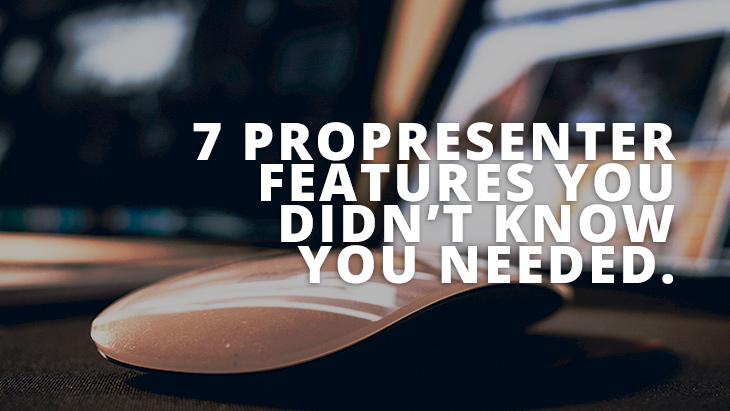The secret to better video communications is right under your nose.
So far, we’ve written about why your business’s website needs more video, ways to make your video accessible to a wider audience, and reasons to ramp up your video marketing this year. But how do you get there? Whether you’re hiring a professional video production company or looking to try out video communications on your own, this one simple trick will change the way you approach the subject.
THE “MORE” BUBBLE
It’s a thing. The “More” Bubble is this idea that the people of today get caught in this “bubble” of constantly wanting and and taking on more. An example of this for the purposes of this blog post is a businessperson who just can’t seem to say no. A coworker comes to them with a project and suddenly the 90 other things they were working on get pushed back to make room for this one assignment. Their workload never lightened. None of their previous responsibilities dropped off to make room for the new one. And they didn’t tell their coworker that they’ll get to it later.
This happens all the time in business. We get caught in the “More” Bubble and just take on more and more work until we find ourselves so busy in head-down execution mode that we forget to come up for air and see what the world looks like. There are so many problems with working this way. Sometimes it’s that you’ve been working on a problem for so long and you become frustrated that you haven’t found the solution yet. A lot of times, it’s right there in front of you. All you need to do is pick your head up.
Other times the problem with the “More” Bubble is that it feels like you’re doing a great job because you feel busy, when really the work you’re putting out is cheap and ineffective. The result of working like this is burnt-out employees (or volunteers) and communications that your audience doesn’t believe in. Want to create video and other media communications that will matter to the consumer? The answer is so simple you won’t believe it.
Spend some time conducting good, old-fashioned research and analysis.
R&A TO THE RESCUE
Let’s imagine a scenario. John graduated from The Ohio State University 25 years ago. Now he’s working in communications for a non-profit organization that is designed for students who are attending the university today. Because of the age gap, he’s not sure what interests and motivates students anymore. He wants to know their point of view. How could John learn their attitudes, beliefs, and expectations in order to better communicate with them?
Marcel Proust once said, “The real act of discovery consists not in finding new lands but in seeing with new eyes.” That’s exactly what research and analysis does for us. It gives us a chance to see with new eyes and learn something new. You can’t effectively communicate with your audience unless you know who your audience is. Research and analysis helps us know our audience.
If John conducted some research on his target audience he would probably find that they’re between the ages of 18 and 25, they make friends easily, and they love to watch short videos online—to name a few characteristics. Even with only three points to work with, John has enough to begin creating audience personas and developing communications that will speak to each one.
As you conduct research on your target audience, some things you might want to look for are the human basics like age, race, sex, ethnicity, and income class. Then you may want to expand and find their likes and dislikes, their level of interaction with social media, the number of online videos they watch per day. You could conduct research out in the field and ask students to take a survey—or do research right at home on your computer. But be careful not to believe everything you read on the Internet. Although it’s full of good and true information, it’s often filled with misleading content as well. Some tips for online research:
- Multiple sources confirmed.
- Internet research based on trusted sources (Bob’s Market Research Findings probably won’t give you info that’s as accurate as the U.S. Census Bureau).
- How long the source has been around.
- Other topics they’ve covered and the facts therein.
If you’re main objective is to create video marketing that speaks to your audience, you should also research things like Internet trends for video watching. You may find that you should include subtitles because your audience is an older group and they understand the message better when it’s reinforced with text. Or you may be able to get creative with dynamic shots that switch quickly for a younger group. When you find out what does and doesn’t work to whom in the world of video and communications, you’ll be much better prepared to create messages that call your desired audience to action.
Once you’ve collected all your findings during the research phase, it’s time to analyze. Sounds intimidating, but really you’re just compiling all of your data, organizing it, and making note of particularly important findings.
PRESENT YOUR FINDINGS
You probably have a person or group of people who need to know what you’ve discovered. At this point, it’s important to hold a meeting with them and present your findings. They may be stakeholders, your in-house video crew, or an outside production company you’ve just hired. Meet with them and give a presentation (a PDF or PowerPoint works just fine—simplicity is key). As you walk them through the content, it’s imperative to express your need-to-haves, your nice-to-haves, things to absolutely avoid, and things for which you’re willing to defer to their expertise. This presentation is the launch pad from which they can jump and create.
Looking to dig into video marketing and truly reach your target audience? Media Images has nearly 20 years of experience in media production and has the creative expertise to help you reach your audience. Let’s get started.





